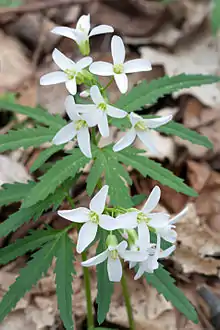Cardamine concatenata
Cardamine concatenata, the cutleaved toothwort, crow's toes, pepper root or purple-flowered toothwort, is a flowering plant in Brassicaceae. It owes its name to the tooth-like appearance of its rhizome.[1] It is a perennial woodland wildflower native to eastern North America.[2] It is considered a spring ephemeral and blooms in March, April, and/or May.[1]
| Cardamine concatenata | |
|---|---|
 | |
| Scientific classification | |
| Kingdom: | Plantae |
| Clade: | Tracheophytes |
| Clade: | Angiosperms |
| Clade: | Eudicots |
| Clade: | Rosids |
| Order: | Brassicales |
| Family: | Brassicaceae |
| Genus: | Cardamine |
| Species: | C. concatenata |
| Binomial name | |
| Cardamine concatenata (Michx.) O. Schwarz. | |
| Synonyms | |
|
Cardamine laciniata | |
Description
The vegetative parts of this plant, which can reach 20–40 cm, arise from a segmented rhizome. The leaves are on long petioles, deeply and palmately dissected into five segments with large "teeth" on the margins. The white to pinkish flowers are held above the foliage in a spike. Fruit is an elongated pod which can be up to 4 cm long.[1][3]
Uses
The roots can be washed, chopped and ground in vinegar to be used as a horseradish substitute.[3]
References
- "Lady Bird Johnson Wildflower Center - The University of Texas at Austin". www.wildflower.org. Retrieved 2018-10-10.
- "Plants Profile for Cardamine concatenata (cutleaf toothwort)". plants.usda.gov. Retrieved 2018-10-10.
- Elias, Thomas S.; Dykeman, Peter A. (2009) [1982]. Edible Wild Plants: A North American Field Guide to Over 200 Natural Foods. New York: Sterling. p. 81. ISBN 978-1-4027-6715-9. OCLC 244766414.
